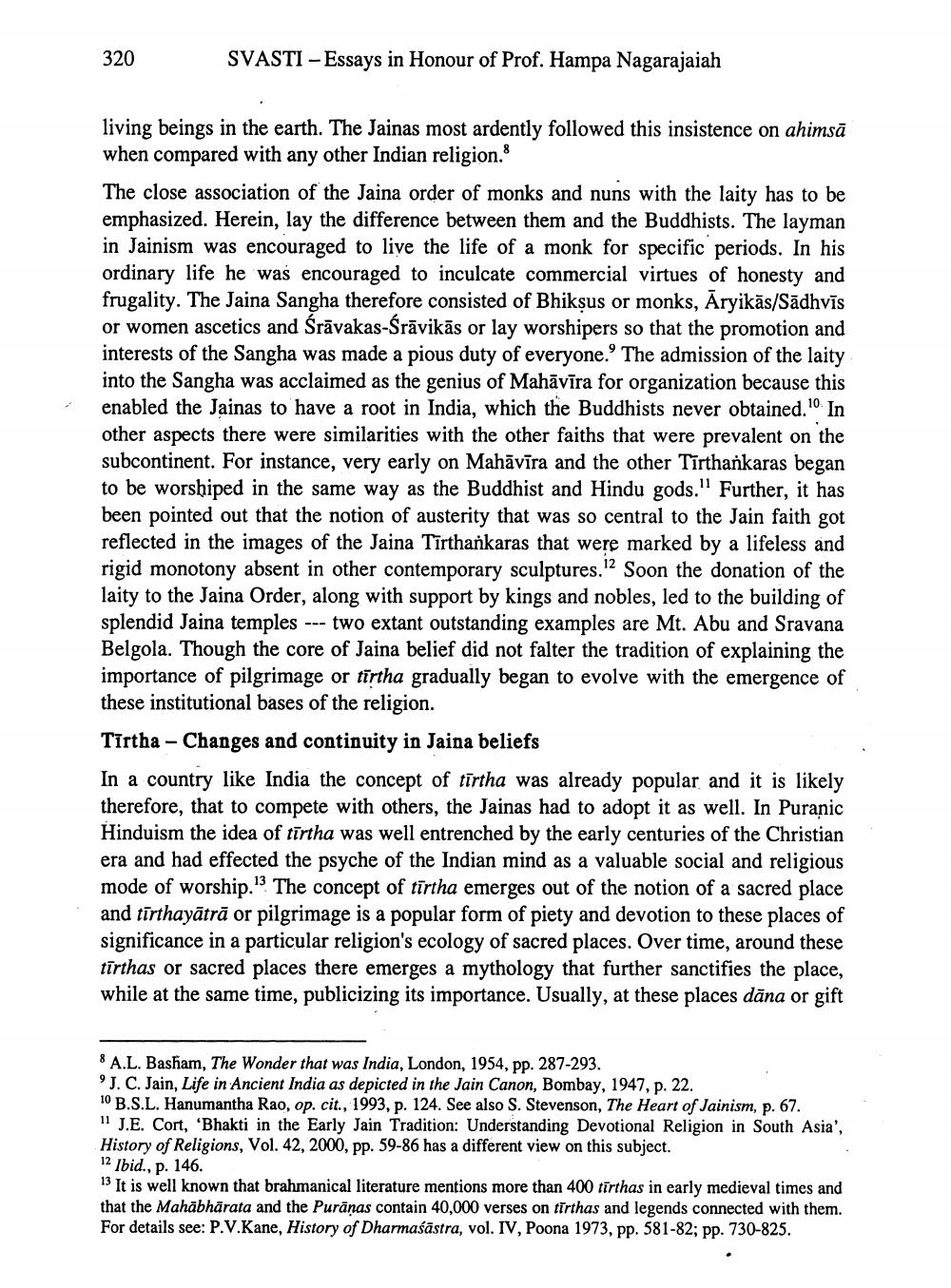________________
320
SVASTI -Essays in Honour of Prof. Hampa Nagarajaiah
living beings in the earth. The Jainas most ardently followed this insistence on ahimsă when compared with any other Indian religion."
The close association of the Jaina order of monks and nuns with the laity has to be emphasized. Herein, lay the difference between them and the Buddhists. The layman in Jainism was encouraged to live the life of a monk for specific periods. In his ordinary life he was encouraged to inculcate commercial virtues of honesty and frugality. The Jaina Sangha therefore consisted of Bhiksus or monks, Āryikās/Sādhvis or women ascetics and Śrävakas-Śrävikäs or lay worshipers so that the promotion and interests of the Sangha was made a pious duty of everyone." The admission of the laity into the Sangha was acclaimed as the genius of Mahāvīra for organization because this enabled the Jainas to have a root in India, which the Buddhists never obtained.10 In other aspects there were similarities with the other faiths that were prevalent on the subcontinent. For instance, very early on Mahāvīra and the other Tirthankaras began to be worshiped in the same way as the Buddhist and Hindu gods." Further, it has been pointed out that the notion of austerity that was so central to the Jain faith got reflected in the images of the Jaina Tirthankaras that were marked by a lifeless and rigid monotony absent in other contemporary sculptures.12 Soon the donation of the laity to the Jaina Order, along with support by kings and nobles, led to the building of splendid Jaina temples --- two extant outstanding examples are Mt. Abu and Sravana Belgola. Though the core of Jaina belief did not falter the tradition of explaining the importance of pilgrimage or tirtha gradually began to evolve with the emergence of these institutional bases of the religion.
Tīrtha Changes and continuity in Jaina beliefs
In a country like India the concept of tirtha was already popular and it is likely therefore, that to compete with others, the Jainas had to adopt it as well. In Puranic Hinduism the idea of tirtha was well entrenched by the early centuries of the Christian era and had effected the psyche of the Indian mind as a valuable social and religious mode of worship." The concept of tirtha emerges out of the notion of a sacred place and tirthayātrā or pilgrimage is a popular form of piety and devotion to these places of significance in a particular religion's ecology of sacred places. Over time, around these tirthas or sacred places there emerges a mythology that further sanctifies the place, while at the same time, publicizing its importance. Usually, at these places däna or gift
8A.L. Basham, The Wonder that was India, London, 1954, pp. 287-293.
9 J. C. Jain, Life in Ancient India as depicted in the Jain Canon, Bombay, 1947, p. 22.
10 B.S.L. Hanumantha Rao, op. cit., 1993, p. 124. See also S. Stevenson, The Heart of Jainism, p. 67.
11 J.E. Cort, 'Bhakti in the Early Jain Tradition: Understanding Devotional Religion in South Asia', History of Religions, Vol. 42, 2000, pp. 59-86 has a different view on this subject.
12 Ibid., p. 146.
13 It is well known that brahmanical literature mentions more than 400 tīrthas in early medieval times and that the Mahabharata and the Purānas contain 40,000 verses on tīrthas and legends connected with them. For details see: P.V.Kane, History of Dharmasastra, vol. IV, Poona 1973, pp. 581-82; pp. 730-825.




